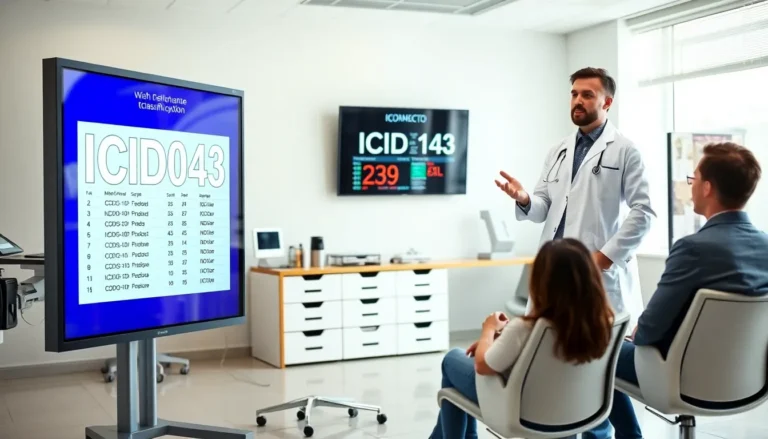Table of Contents
ToggleOn-again off-again relationships are like that favorite TV show that keeps getting renewed and canceled—thrilling yet frustrating. One moment, they’re the love of your life, and the next, they’re ghosting like a bad horror movie. It’s a rollercoaster of emotions that can leave anyone dizzy and questioning their sanity.
But why do so many people find themselves stuck in this cycle? Is it love, convenience, or just the thrill of the chase? Whether it’s rekindling old flames or navigating the chaos of breakups, these relationships spark curiosity and intrigue. Get ready to dive into the wild world of on-again off-again dynamics, where love is never quite straightforward and every reunion feels like a plot twist waiting to happen.
Understanding On-Again Off-Again Relationships
On-again off-again relationships are characterized by cycles of breaking up and reconciling. These connections often lead to intense emotional experiences that can confuse individuals.
Definition and Characteristics
On-again off-again relationships involve inconsistent commitment between partners. Conflicting emotions typify these bonds, combining love, frustration, and uncertainty. Partners might alternate between deep affection and emotional distance. Trust issues often surface, complicating communication further. Patterns of dependency may emerge, causing one or both partners to rely on the relationship despite its instability. Emotional highs and lows frequently create a rollercoaster effect, contributing to significant stress. Relationship dynamics often shift, raising questions about long-term compatibility.
Common Patterns Observed
Repeated cycles define on-again off-again relationships, leading to familiar behaviors. Partners may possess a tendency to reconnect after a brief separation. Emotional triggers usually spur reconciliations, with one partner reaching out during moments of loneliness. Arguments often ignite the breakups, followed by regret and longing. External influences like friends or family might exacerbate decisions to separate or reunite. Attraction can waver due to unresolved issues, complicating emotional stability. Ultimately, these relationships showcase a struggle to achieve lasting commitment amidst continuous ups and downs.
Causes of On-Again Off-Again Relationships

On-again off-again relationships often stem from a combination of emotional and psychological factors. Understanding these causes sheds light on the reasons behind such cyclical dynamics.
Emotional Attachment
Emotional attachment plays a critical role in maintaining on-again off-again relationships. Individuals often feel a deep bond despite conflicts. This bond can lead them to overlook red flags and unhealthy patterns. Loyalty and affection frequently intertwine, making it difficult to let go completely. Partners may find themselves reminiscing about happier moments, which rekindles feelings of love. Emotional highs and lows can solidify the connection, reinforcing the cycle. Even temporary separations may not erase feelings accumulated over time. The challenge lies in balancing attachment with the reality of the relationship’s instability.
Fear of Loneliness
Fear of loneliness often drives individuals back into conflicted relationships. Many people struggle with the thought of being alone, leading them to choose familiarity over uncertainty. This fear creates a strong pull toward the comfort of past connections. The discomfort associated with solitude can overshadow the negative aspects of the relationship. In some cases, partners may convince themselves that the relationship is better than facing loneliness. External influences, such as social circles or familial expectations, may amplify this fear. Consequently, individuals may stay in the relationship despite knowing it lacks stability or fulfillment.
The Impact on Individuals
On-again off-again relationships lead to significant emotional and psychological effects on individuals. Partners often endure cycles of joy and despair, which contribute to lasting emotional scars.
Psychological Effects
Emotional instability frequently arises in these relationships. Individuals experience anxiety from uncertainty about their partner’s feelings. Frequent breakups and reconciliations enhance this anxiety, leading to depression in some cases. This persistent turmoil can weaken self-esteem and foster feelings of inadequacy. Trust issues become prevalent, as partners question each other’s reliability. Communication suffers due to unresolved conflicts, making emotional expression difficult. Individuals struggle with confusion about their identity and value, often doubting if they deserve better.
Long-Term Consequences
Long-term involvement in such relationships can yield severe repercussions. Patterns of dependency often develop, making it challenging for individuals to establish healthy connections outside the relationship. They may become conditioned to accept unhealthy dynamics as normal. Emotional resilience suffers, increasing the risk of developing attachment issues in future relationships. Individuals might struggle to maintain boundaries, leading to repeated cycles of dysfunction. Ultimately, these experiences can hinder personal growth and foster a sense of hopelessness regarding future romantic prospects.
Navigating On-Again Off-Again Relationships
Understanding how to navigate on-again off-again relationships requires clear strategies and insight into personal boundaries. Emotional awareness plays a crucial role in fostering healthy dynamics.
Strategies for Improvement
Identifying patterns within the relationship can help partners address underlying issues. Setting boundaries creates a sense of safety and clarity for both individuals. Communication techniques, such as active listening, enhance understanding and reduce misunderstandings. Regular check-ins can assist each partner in expressing thoughts and feelings openly. Seeking professional guidance can provide tools and perspectives that promote healthier interaction. Acknowledging individual needs fosters personal growth and can shift the relationship dynamic positively.
When to Let Go
Recognizing signs of toxicity becomes paramount when evaluating the future of the relationship. Patterns of repeated arguments and feelings of isolation indicate a problematic cycle. Considerations such as consistent emotional distress and lack of trust pave the way for personal reflection. Reflecting on one’s worth encourages individuals to examine their happiness outside the connection. If partners find themselves stuck in a loop with no progress, letting go may lead to healthier futures. Moving on can cultivate personal growth and open the door to more fulfilling relationships.
On-again off-again relationships can be emotionally draining and complex. They often leave individuals questioning their feelings and the stability of their connections. Recognizing the patterns and emotional triggers is essential for breaking free from these cycles.
Setting boundaries and fostering open communication can pave the way for healthier interactions. Individuals must reflect on their self-worth and happiness outside the relationship to gain clarity. Ultimately, moving on can lead to personal growth and the opportunity for more fulfilling connections. Embracing change is a vital step toward a healthier emotional future.







